- Quick Read
- Deep Read ( 6 Min. )

Why is Christian Science in our name?
Our name is about honesty. The Monitor is owned by The Christian Science Church, and we’ve always been transparent about that.
The Church publishes the Monitor because it sees good journalism as vital to progress in the world. Since 1908, we’ve aimed “to injure no man, but to bless all mankind,” as our founder, Mary Baker Eddy, put it.
Here, you’ll find award-winning journalism not driven by commercial influences – a news organization that takes seriously its mission to uplift the world by seeking solutions and finding reasons for credible hope.
Explore values journalism About usIn Today’s Issue
- Biden signs a historic climate bill. So what will it actually do?
- Climate bill offers boost to EVs. Why short-term sales may slump.
- New law could mark end of American Confederacy – in Brazil
- Why Nayyab Ali puts her life on the line to protect trans Pakistanis
- The curse of cursive: Why Dave and I need forensics for our cookware
Monitor Daily Podcast
- Follow us:
- Apple Podcasts
- Spotify
- RSS Feed
- Download
TODAY’S INTRO
How a kids’ book about a rabbit can teach adults not to despair
 April Austin
April Austin
Could a fable about a rabbit be an antidote to despair? After reading “Alice’s Farm: A Rabbit’s Tale” by Maryrose Wood, I would answer an emphatic yes. This delightful book, aimed at 8- to 12-year olds, has captured adult readers as well. Alice, an eastern cottontail rabbit, rallies the animals in the forest – even those who would prefer to eat her – to save a family farm from developers.
“Writing children’s literature is a sneaky side door to writing stories that are animated by hope,” Ms. Wood says in an interview. “I want to offer tales that have the possibility of change; that things actually can get better. And the truth is that many adults appreciate those kinds of stories too.”
The book is gentle, honest, and poignant. It’s also a primer on how to improve one’s own patch of ground without falling prey to frustration or helplessness. Ms. Wood knows that people feel overwhelmed by what’s happening in the world. The drumbeat of news “makes us think that we are in a race to the bottom, we are facing doom on multiple fronts,” she says. “That’s a tough one, because when we are overwhelmed, it’s paralyzing. And I don’t think paralysis is a useful strategy.”
Alice may harbor doubts about her own effectiveness, but she accepts the challenge of convincing the animals – even the fox and weasel – to work together despite their differences. Most important, Alice finds the single thing all the animals can agree on: They don’t want to lose their home.
As a model of floppy-eared patience, Alice wriggles her way into your heart. “Isn’t it so often an unlikely hero, some person who steps forward and is willing to speak or to be vulnerable – that we almost instantly respond to them?” Ms. Wood asks. “We respond to true acts of heroism. It’s not feats of strength.”
She continues, “Alice totally embraces her vulnerability. And if you embrace vulnerability with that degree of honesty, I think you get two things out of it. You get compassion, right? But in addition to compassion, I think the other thing it gives you is a kind of rock-solid bravery.”
Share this article
Link copied.

Help fund Monitor journalism for $11/ month
Already a subscriber? Login

Monitor journalism changes lives because we open that too-small box that most people think they live in. We believe news can and should expand a sense of identity and possibility beyond narrow conventional expectations.
Our work isn't possible without your support.
The Explainer
Biden signs a historic climate bill. So what will it actually do?
The Inflation Reduction Act will allocate billions to combat climate change, while lowering the cost of some prescription drugs and cutting the deficit, although some analysts say it will not meaningfully impact inflation.

On Tuesday, President Joe Biden signed into law the Inflation Reduction Act, among the most significant legislative achievements of his presidency. It represents a historic investment in measures aimed at combating climate change, lowering the cost of some prescription drugs, and raising enough revenues to cut the deficit rather than adding to it.
According to a summary by Senate Democrats, the bill will invest $437 billion over the next decade, nearly 85% of which go to climate and energy security provisions. To pay for them, it will raise an estimated $737 billion in revenues through a new corporate minimum tax, prescription drug pricing reform, stepped-up IRS enforcement of tax rules, and an excise tax on stock buybacks. The surplus $300 billion would then be put toward cutting the deficit. That represents about 1% of the national debt, which has topped $30 trillion for the first time.
Democrats’ revenue estimates may be overly optimistic; the nonpartisan Congressional Budget Office estimates that the bill will not meaningfully cut inflation and will only reduce the deficit by $100 billion. But others, such as former Clinton Treasury Secretary Lawrence Summers, believe the bill’s IRS reform provisions will generate far more revenue than the CBO estimates.
Biden signs a historic climate bill. So what will it actually do?
On Tuesday afternoon, President Joe Biden signed into law the Inflation Reduction Act, among the most significant legislative achievements of his presidency. It represents a historic investment in measures aimed at combating climate change, lowering the cost of some prescription drugs, and raising enough revenues to cut the deficit rather than adding to it. The bill is a slimmed-down version of last year’s failed $3.5 trillion Build Back Better bill, which would have significantly expanded the social safety net and made even bigger investments in climate and clean energy initiatives.
According to a summary by Senate Democrats, the bill will invest $437 billion over the next decade, nearly 85% of which go to climate and energy security provisions. To pay for them, it will raise an estimated $737 billion in revenues through a new corporate minimum tax, prescription drug pricing reform, stepped-up IRS enforcement of tax rules, and an excise tax on stock buybacks. The surplus $300 billion would then be put toward cutting the deficit. That represents about 1% of the national debt, which has topped $30 trillion for the first time.
Democrats’ revenue estimates may be overly optimistic; the nonpartisan Congressional Budget Office estimates that the bill will not meaningfully cut inflation and will only reduce the deficit by $100 billion. But others, such as former Clinton Treasury Secretary Lawrence Summers, who sounded early warnings last year on inflation, believe the bill’s IRS reform provisions will generate far more revenue than the CBO estimates.
So, what will it do?
Despite the downsizing of the bill, it still represents the largest-ever investment in initiatives meant to mitigate climate change, estimated at $369 billion. That includes $60 billion in environmental justice priorities, ranging from community-led pollution monitoring to mitigating the climate and health risks of urban heat islands.
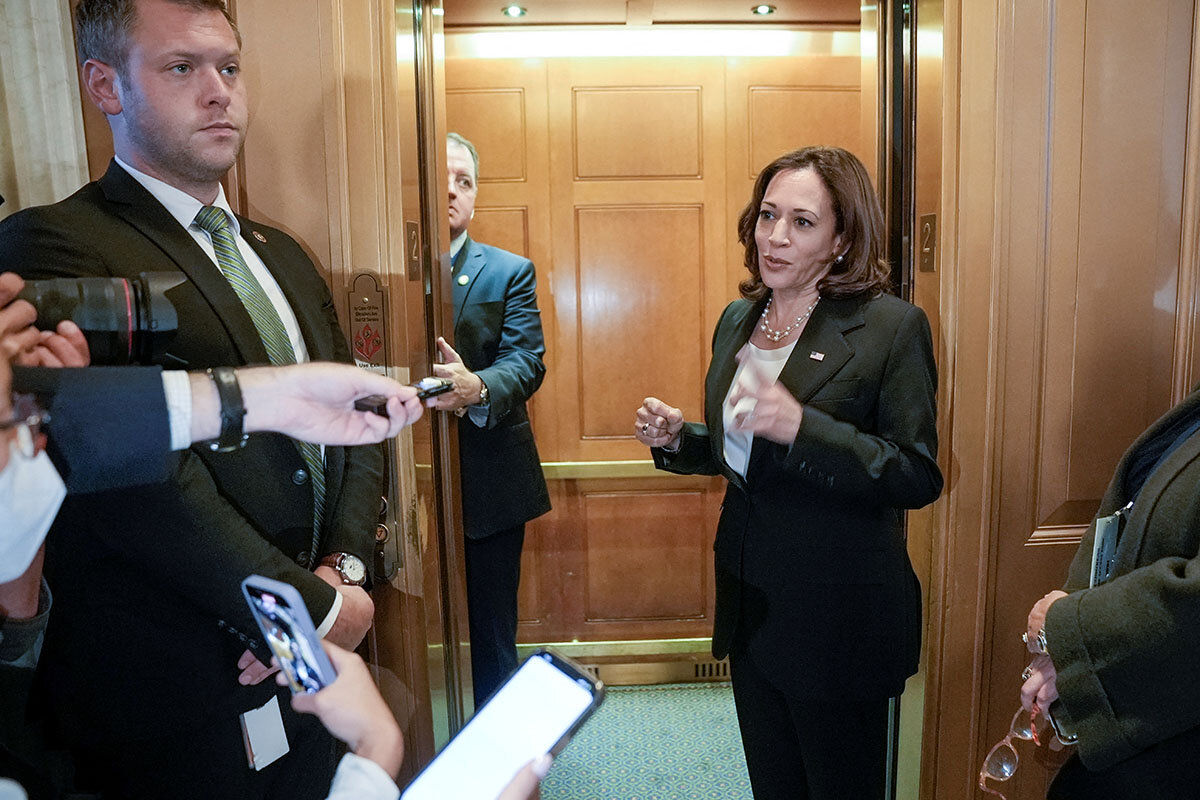
Among the largest line items are $27 billion for projects that reduce greenhouse gas emissions, more than half of which is allocated for low-income and disadvantaged communities; $10 billion for the long-term resiliency, reliability, and affordability of rural electric systems; and $3 billion for the U.S. Postal Service to buy zero-emission vehicles. There is also $4.3 billion for home energy-efficiency rebates of up to $4,000, or $8,000 for low- or moderate-income households. The agricultural sector is included as well, with programs focused on helping farmers, ranchers, and forest landowners monitor and address climate issues, including greenhouse gas emissions. Democrats say the bill will cut carbon emissions to 40% of 2005 levels by 2030.
Some of the investments in clean energy, such as offshore wind development, are tied to requirements for government lease sales to oil and gas companies, which have been largely frozen under the Biden administration. However, the bill increases the cost per acre of such fossil fuel extraction tenfold, from $1.50 per acre to a minimum of $15 over the decade. It also incentivizes carbon capture technology and facilities, which oil-rich states North Dakota and Wyoming have been pioneering to produce lower-carbon energy.
“It’s an amazing moment for the country and the world to have bold action on climate finally pass the Congress,” California Rep. Ro Khanna, deputy whip of the Congressional Progressive Caucus, told the Monitor as his Democratic colleagues’ cheers echoed through the Capitol’s hallways shortly after the bill passed on Aug. 12. “It’s a moment of pride for everyone in the Congress that we’re part of this historic effort.”
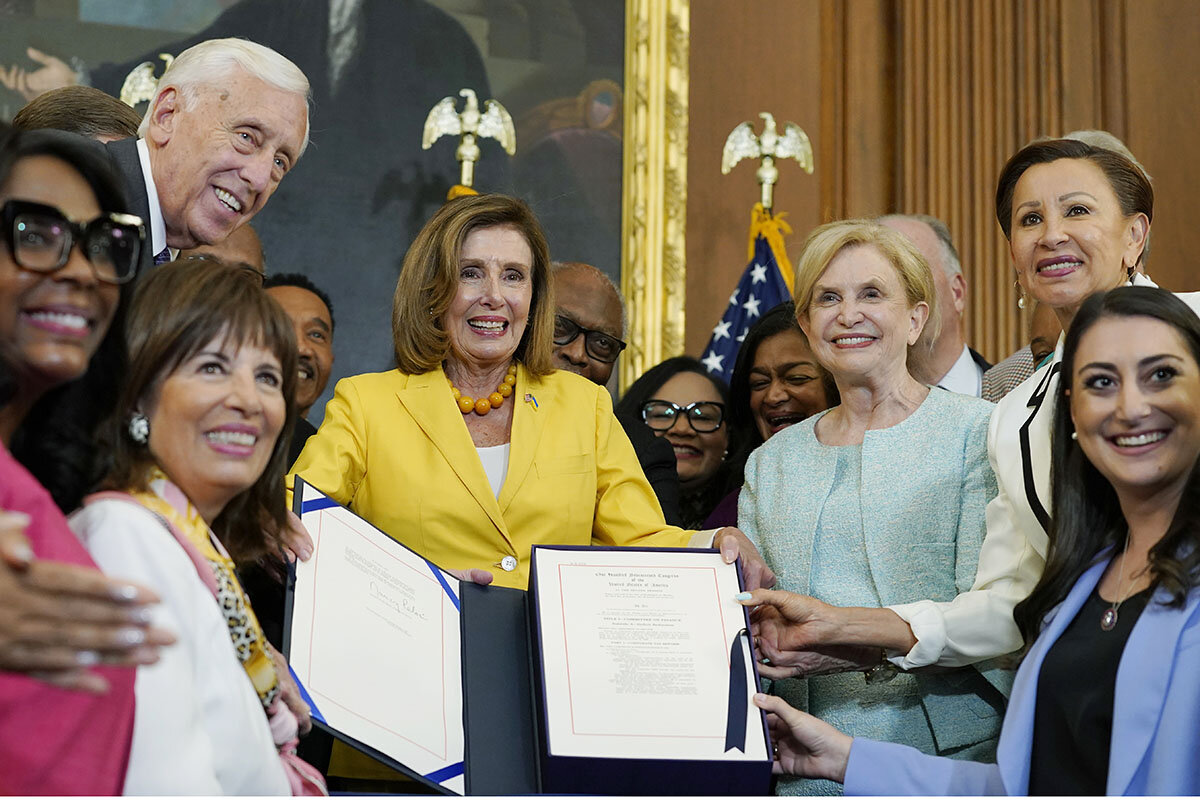
The bill also extends for another three years Affordable Care Act subsidies for families within 400% of the poverty line, which were enacted as part of last year’s $1.9 trillion American Rescue Plan and set to expire this year. And it makes a modest investment in drought resilience – a provision that was key to winning the support of Democratic Sen. Kyrsten Sinema of Arizona. All 50 Senate Democrats, plus Vice President Kamala Harris’ tie-breaking vote, were needed to pass the bill.
The 728-page bill outlines billions of dollars in spending for which little direction is given, such as $1.26 billion allocated for Federal Highway Administration grants in economically disadvantaged communities or a conservation stewardship program for the agricultural sector whose annual allocation would gradually grow to $1.5 billion. Decisions about how exactly to spend much of the funding will likely be made by unelected administrators within federal agencies.
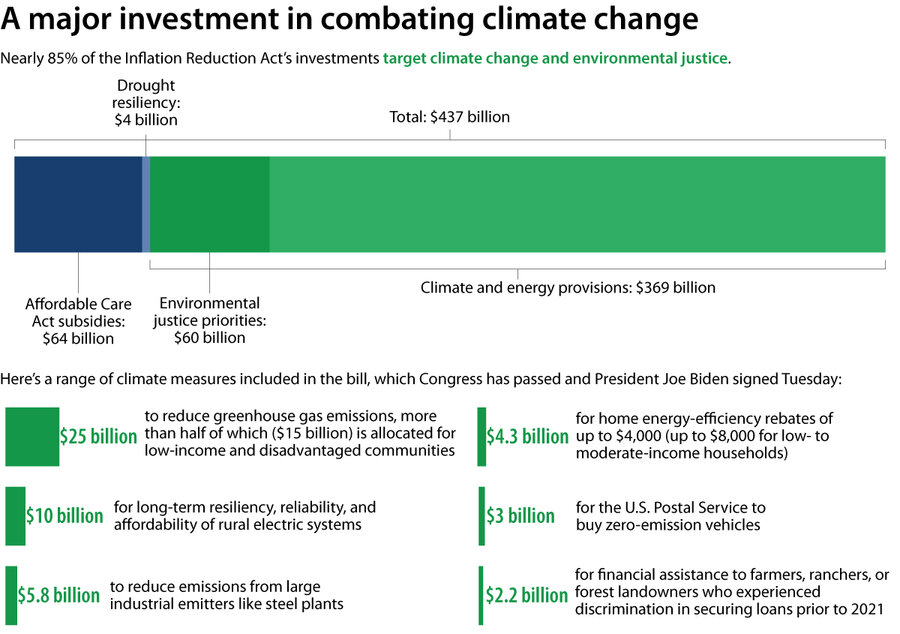
Legislative text of the Inflation Reduction Act (H.R. 5376), Senate Democrats summaries, and analyses by the Congressional Budget Office, Joint Committee on Taxation, and Tax Foundation
How will these investments be paid for?
The bill outlines a number of tax changes and increased tax enforcement, as well as prescription drug pricing reform to pay for these investments and also pay down the deficit. A 15% minimum tax on corporations making $1 billion or more for three consecutive years is estimated to bring in $222 billion, according to the Joint Committee on Taxation – about a third of total revenue raised by the legislation. Other analyses estimate that actual revenues would be lower, given the likelihood that corporations would try to find workarounds.
In addition, the bill extends a limitation on “pass-through” business losses and adds a 1% tax on stock buybacks – a last-minute addition to replace a carried-interest provision that would have affected private-equity executives, which Senator Sinema objected to. It will also invest $80 billion in the IRS, including $45 billion for stepped-up enforcement such as criminal investigations and digital asset monitoring and compliance. The CBO, which last year estimated that such an investment would more than double the IRS workforce, estimates that the increased enforcement will net $124 billion.
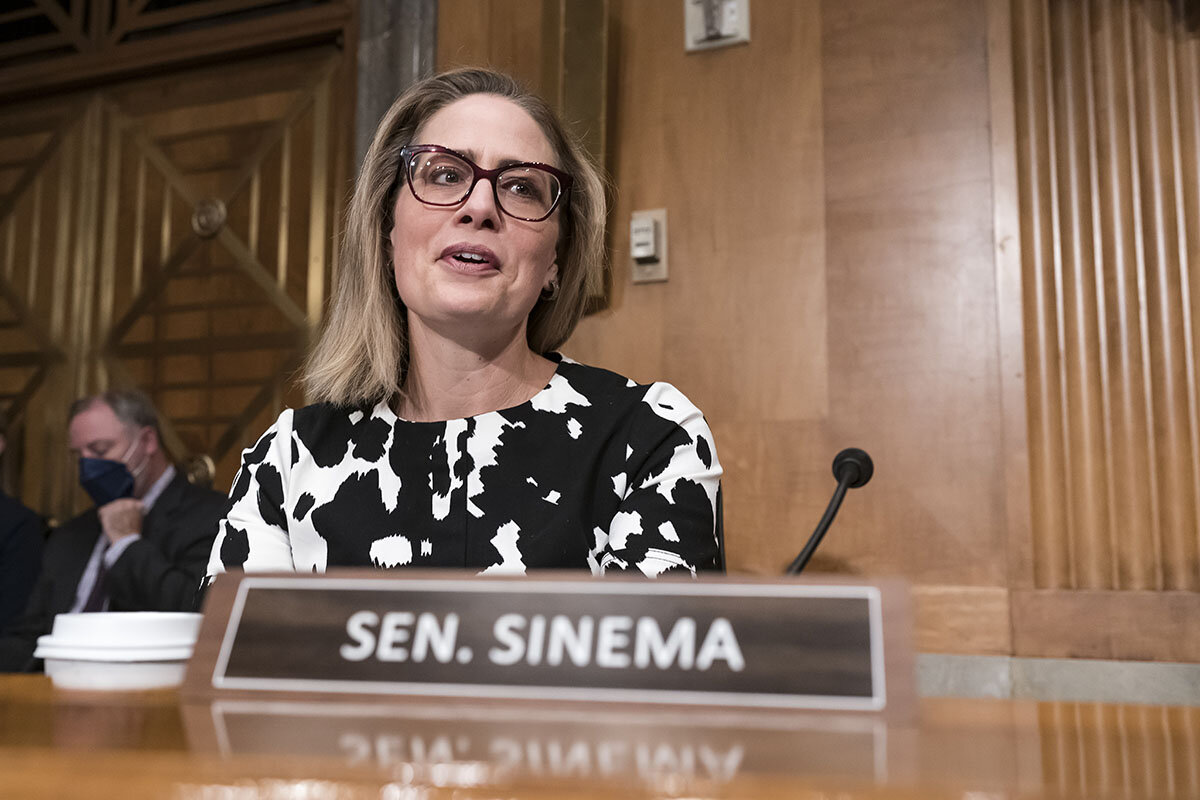
Another major revenue source is prescription drug pricing reform, though it was pared down somewhat by the Senate parliamentarian, who can reject certain parts of legislation that do not qualify for budget reconciliation. This will allow Medicare to negotiate the prices of 10 major drugs by 2026, and 20 by 2029, saving the government money. It will also keep costs down for seniors on Medicare; starting in 2025, their annual out-of-pocket drug costs will be capped at $2,000.
Will it reduce inflation? What about the deficit?
The CBO projects no impact on inflation this year and a +/- 0.1% change in 2023. “The impact on inflation is statistically indistinguishable from zero,” wrote another nonpartisan budget modeling group, Penn Wharton, which estimated a slight increase in inflation in the first few years and then a slight reduction toward the end of the decade.
Sen. Joe Manchin, a West Virginia Democrat who was largely responsible for blocking the original Build Back Better plan due to his concerns over inflation, said on CNN he “respectfully disagrees” with Penn Wharton’s assessment.
Rep. Jason Smith of Missouri, the top Republican on the House Budget Committee, points out that due to the phased-in timing of some of the revenue-raising measures, 80% of the deficit reduction won’t come until after 2029.
“With raising taxes, increasing inflation, and doubling the size of the IRS, it’s the complete wrong recipe for America,” he told the Monitor in a brief hallway interview.
How will it affect Americans’ taxes?
President Biden promised not to raise new taxes on Americans making less than $400,000, and he and his Democratic allies say that most of the additional tax revenue generated by this bill, including from the stepped-up IRS enforcement, will come from the country’s wealthiest corporations and individuals. However, Penn Wharton estimated that earners in all five quintiles will have less after-tax income, and the CBO estimated that those making less than $400,000 would pay $20 billion more in taxes over the next decade.
One of the biggest line items that was cut from the original Build Back Better bill is the expanded child tax credit, which last year’s American Rescue Plan increased to $3,600 per eligible child under age 6 and $3,000 for those ages 6 to 17. Senate Budget Committee Chair Bernie Sanders of Vermont, who had wanted $6 billion for the Build Back Better plan, pressed to include it in the Inflation Reduction Act but did not succeed.

Legislative text of the Inflation Reduction Act (H.R. 5376), Senate Democrats summaries, and analyses by the Congressional Budget Office, Joint Committee on Taxation, and Tax Foundation

Climate bill offers boost to EVs. Why short-term sales may slump.
The largest climate bill in U.S. history makes several trade-offs. There are subsidies for electric vehicles. But those come with asterisks about where materials are sourced.

- Quick Read
- Deep Read ( 6 Min. )
The outlook for America’s electric vehicles is bright. Sales and registrations of EVs are starting to rocket upward. President Joe Biden is poised to sign a climate change bill today that would shower drivers with even better incentives to go electric.
But those subsidies may short-circuit EV sales, at least for the short term. In trying to balance competing interests, Congress has passed a bill that will force automakers to diversify away from China, retool their supply chains, and make less expensive cars if they want their products to qualify for the incentives.
There’s no question that the bill represents the United States’ boldest move yet to address climate change. Most of the funding goes toward reducing greenhouse gas emissions through tax credits and rebates for solar, wind, and other green technologies, including EVs. The vehicle portion of the bill illustrates the economic, environmental, political, and geopolitical trade-offs involved in trying to move the U.S. to a lower carbon future.
“There are always going to be these compromises,” says Erich Muehlegger, an economics professor at the University of California, Davis who has studied EV subsidies. “The real question comes down to, how do you balance these multiple objectives?”
Climate bill offers boost to EVs. Why short-term sales may slump.

The outlook for America’s electric vehicles is bright. Sales and registrations of EVs are starting to rocket upward. President Joe Biden is poised to sign a climate change bill today that would shower drivers with even better incentives to go electric.
But those subsidies may short-circuit EV sales, at least for the short term. In trying to balance competing interests, Congress has passed a bill that will force automakers to diversify away from China, retool their supply chains, and make less expensive cars if they want their products to qualify for the incentives.
There’s no question that the bill represents the United States’ boldest move yet to address climate change, causing House Democrats to cheer after passing it Friday and leaving Republicans fuming at the $437 billion in new spending and the $737 billion in taxes and other measures to pay for it. Although named the Inflation Reduction Act – its impact on inflation is expected to be negligible – the bill expands Medicare benefits and allows the federal government to negotiate some drug prices for Medicare. Most of the funding goes toward reducing greenhouse gas emissions through tax credits and rebates for solar, wind, and other green technologies, including EVs. The vehicle portion of the bill illustrates the economic, environmental, political, and geopolitical trade-offs involved in trying to move the U.S. to a lower carbon future.
“There are always going to be these compromises,” says Erich Muehlegger, an economics professor at the University of California, Davis who has studied EV subsidies. “The real question comes down to, how do you balance these multiple objectives?”
EV advocates and major U.S. automakers applaud the bill. For one, it extends for 10 years the $7,500 federal tax credit and eliminates the current cap that begins reducing the credit once an automaker has sold 200,000 EVs. Tesla and General Motors have already exceeded that limit and are at a sales disadvantage vis-à-vis newer entrants. The legislation also makes the credit immediately available to car buyers, who can sign it over to their dealer and get the discount right away, rather than having to wait to file their taxes.
Used EVs also become eligible for a partial tax credit of up to $4,000.
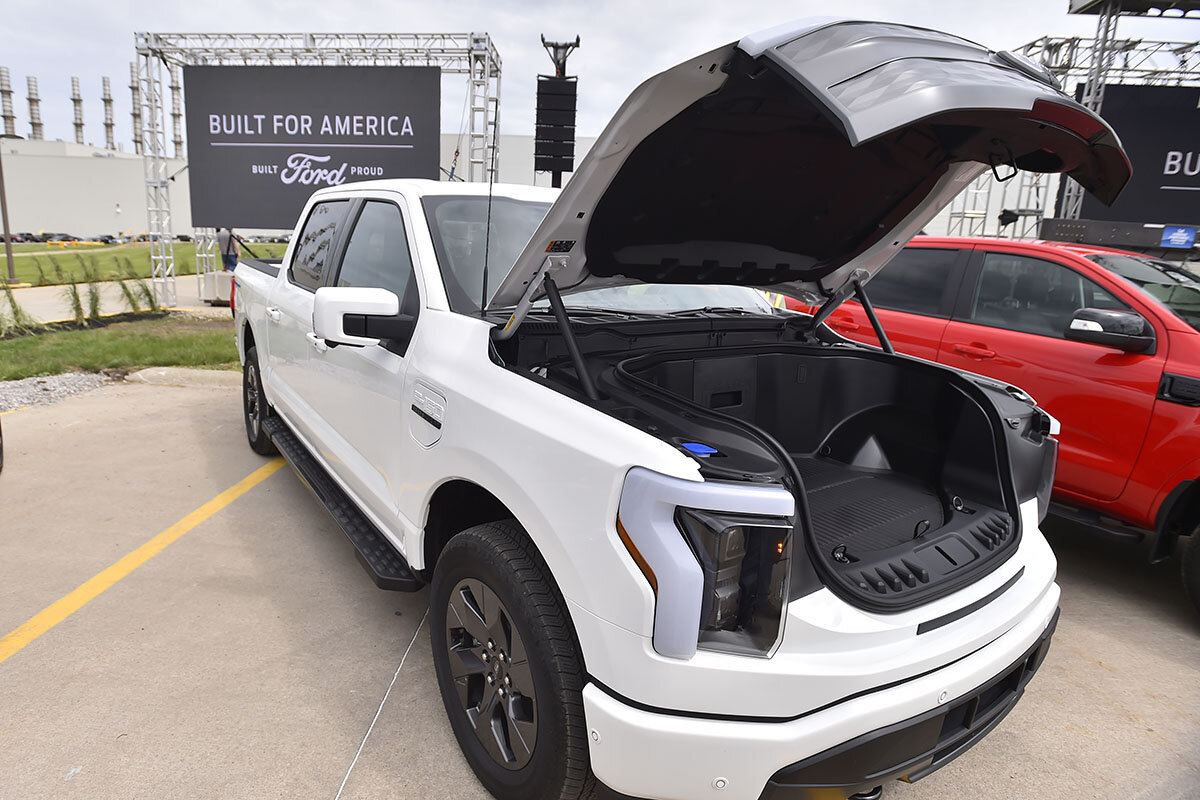
Manufacturers will have to bring down their prices, however. The average EV today costs more than $66,000, Kelley Blue Book estimates. The subsidies will only be available for new cars that cost $55,000 or less, new trucks that cost $80,000 or less, and used EVs that cost no more than $25,000. That poses an especially big challenge for EV luxury makers, such as Rivian, which was scrambling to book deals before the president signs the act Tuesday.
Furthermore, the federal government doesn’t intend to subsidize rich EV buyers. Single buyers can’t earn more than $150,000 (joint filers, $300,000) to qualify for the new-car credit. The income limits for used EV buyers are half of what they are for new buyers.
The legislation contains more serious hurdles that will force automakers to retool in a hurry. One is a requirement that EVs must be assembled in North America to qualify for the subsidy. That’s a concern for big domestic manufacturers; it’s a deal breaker for foreign ones, such as Audi and Kia. Another challenge is that 40% of the critical materials used in an EV – a long list including everything from aluminum to yttrium, a rare earth element – must come from the U.S. or from nations that have a free trade agreement with the U.S. The requirement keeps increasing through 2027, when at least 80% of critical materials must come from mines in the U.S. or free trade partners.
Even more potentially difficult is the requirement that starting in 2025, no EV will qualify for the incentive that includes critical materials extracted, processed, or recycled by a “foreign entity of concern” – in other words, China. That’s in line with the Biden administration’s push to spur domestic manufacturing and reduce dependence on China, but it might reduce EV sales in the short term.
When the legislation goes into effect, 70% of EVs, plug-in hybrids, and fuel cell vehicles for sale in the U.S. will no longer qualify for the federal credit, warns John Bozzella, president of the Alliance for Automotive Innovation, which represents domestic and foreign manufacturers. When other sourcing requirements go into effect in the next few years, no EVs will qualify. The alliance’s solution: expand eligible countries to include those with a collective defense arrangement with the U.S., such as NATO nations and Japan.
The bill “reflects a growing commitment to scaling up EVs as a major component of the American economy,” says James Turner, an environmental studies professor at Wellesley College and author of a new book out today, “Charged: A History of Batteries and Lessons for a Clean Energy Future.” But “we need to give people time to adjust and resupply.”
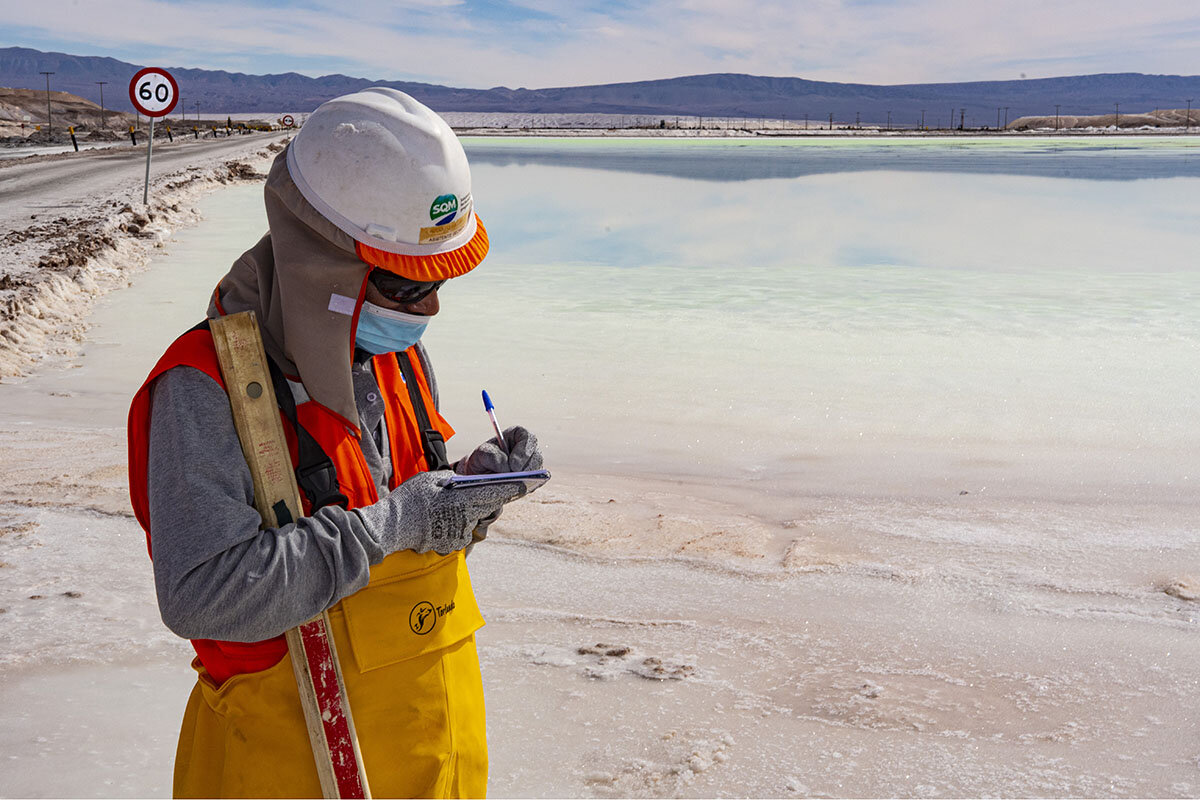
Mining’s impact
The adjustment may require more than is readily apparent because of the control China holds over major portions of the EV battery supply chain.
Take cobalt. Congo (itself a less than ideal supplier because of its poor environmental record and reliance on child labor) produces 69% of the world’s supply, according to a new report from the Peterson Institute for International Economics. But only 3.5% of that supply comes from mining companies incorporated there. Chinese state-owned companies, by contrast, control about 24% of the known supply, the PIIE report calculates. (The ownership of a big chunk of cobalt production is not known.)
Lithium poses a similar challenge. The EV industry will need at least five times the lithium that was produced last year worldwide, according to industry estimates, perhaps more. And lithium prices already have skyrocketed because of surging demand. Although more than half of the world supply comes from Australia, Chinese state-owned companies actually control the top two miners there (an Australian and a Chilean firm) and about a third of the total market, according to the PIIE report.
The U.S. has a significant presence in Australian lithium mining, too, but its ownership is largely through passive investment firms, not state-owned companies controlled by a government. Several U.S. lithium projects have been proposed, but they would have to meet state as well as federal environmental rules and, in California, additional concerns about encroaching on sacred Native lands. More U.S. lithium would also mean more domestic lithium mining.
“Everything has an environmental impact, windmills and solar panels and lithium,” says James Van Nostrand, director of the Center for Energy and Sustainable Development at West Virginia University and author of a new book, “The Coal Trap: How West Virginia Was Left Behind in the Clean Energy Revolution.” The best lawmakers can do is “enforce the environmental laws and you try to minimize the environmental impacts.”
Political trade-offs
The EV boom doesn’t only mean more mining. There are other environmental trade-offs. For example, the U.S. will need less oil but more electricity to power its transportation. And that means increased nuclear power, says Mr. Van Nostrand, if the U.S. is to dramatically reduce its carbon footprint. The nation is currently on a trajectory to reduce 2005 emissions levels by 20% by 2030. The new bill could double that.
Then there are the political trade-offs. When President Biden first unveiled his Build Back Better initiative last year, Democratic liberals and moderates conducted a very public fight over its size and scope. Faced with midterm elections this fall and gloomy prospects for holding on to control of Congress, the liberals swallowed hard and lined up behind legislation heavily influenced by Democratic Sen. Joe Manchin of West Virginia. For example, the Inflation Reduction Act will fund clean coal initiatives, while liberals want to shut down coal production and allow more oil drilling on federal land and waters. The senator also won a deal to streamline approval of a West Virginia natural gas pipeline that many environmentalists oppose.
Even with all these trade-offs, Democrats embraced the plan as the best package they could get through a divided Congress. It squeaked by the Senate, 51-50, with Vice President Kamala Harris casting the tiebreaking vote, and the House, 220-207, along party lines.
“We can always point to drawbacks and things that could have been done better,” says Mr. Muehlegger at the University of California, Davis. “But this act is a very significant step forward.”

New law could mark end of American Confederacy – in Brazil
A new law banning Confederate symbols in a rural Brazilian town tests long-held beliefs about history and identity. It’s also creating opportunity for a more balanced narrative about the past.

- Quick Read
- Deep Read ( 7 Min. )
-
By Sage Behr Contributor
-
Zach Ben-Amots Contributor
In 1866, Confederates fled defeat in the United States and started settling in rural Brazil. They were promised cheap land and labor, and collectively purchased more than 500 enslaved people, according to researchers. For the past four decades, their ancestors have held a festival celebrating their unique ties to the U.S., playing country music and waving Confederate flags.
The focus on the flag has made the tradition increasingly contentious. But following the passage of a local ordinance banning the use of racist symbols at public festivals, the celebration as it has been carried out in the past is now at risk.
The new law has frustrated the Fraternidade Descendência Americana, or FDA, founded by the descendants of Confederate families. “It’s difficult for us to feel bad about something we’re proud of,” says Joao Padoveze, president of the FDA and a self-proclaimed redneck.
But this moment has also created an opportunity. Public discussions are taking place around the need to balance the historical narrative by including largely overlooked voices, like those of Afro-Brazilians.
“For us, [the law] is an advance,” says Silvia Motta, who runs an Afro-Brazilian cultural center. But “it’s a regression for us to keep talking about American culture instead of Black culture.
“That’s the weight of this flag.”
New law could mark end of American Confederacy – in Brazil
The Cemitério do Campo is unlike any other cemetery in Brazil. Located at the end of a dirt road in rural São Paulo state, it’s the site of an estimated 500 graves, a small ecumenical chapel – and one of the world’s largest Confederate flags.
Settled by Confederates fleeing their loss in the U.S. Civil War more than 150 years ago, it’s been host to the Festa Confederada, or Confederate Festival, for the past four decades. Thousands travel from across Brazil to celebrate the legacy of the Confederate States of America, complete with flags and a country music soundtrack. Attendees use “Confederate dollars” to buy chicken and biscuits, while watching reenactments from the antebellum South.
But a new municipal law could mean the end of the annual celebration and any other public event commemorating the Confederacy. The ordinance bans the use of racist symbols at public festivals, and the Confederate flag and this festival in Santa Bárbara d’Oeste are specifically named in the justification for the law, which passed last month with near-unanimous support.
The conflict here mirrors the ongoing debate over Confederate symbols and monuments in the United States, despite taking place thousands of miles south of the Mason-Dixon Line. For residents, however, it’s a hyperlocal dispute about representation and balancing the legacy of slavery in Brazil with the unusual story of American immigrants who settled in this small town a century and a half ago.
The law’s passage has raised the stakes on how this unique history should best be honored. While some are doubling down on the importance of the Confederate flag, others are using the ordinance as an opportunity to give new voice to often-overlooked narratives in Santa Bárbara d’Oeste. How the city identifies a middle ground between remembering the past and recognizing the weight of historic symbols could serve as a road map for other hot-button issues vexing an increasingly polarized Brazil in the future.

“This is an attempt … to reconsider history,” says Sidney Aguilar Filho, a historian and researcher at the University of Campinas, referring to the new law. He says it’s important to revisit and question the past. “The great value of this debate,” he says, is that it could help the community “face sadness and trauma with intellectual and historical honesty, so that we can move forward in our own story.”
Remembering history?
In 1866, Confederados, as they are called in Portuguese, fled defeat in the U.S. and started settling here, lured by offers of cheap land and labor. They collectively purchased more than 500 enslaved people, according to researchers from the Federal University of Tocantins. Some two decades later, Brazil became the last country in the Americas to abolish slavery. The region encompassing Santa Bárbara was the last to enforce the abolition.
“For us, the Confederate flag carries the symbolism of … resistance to tyranny,” not the symbolism of slavery, says João Padoveze, president of the Fraternidade Descendência Americana, or FDA, a group founded by the descendants of Confederate families. Leaders of the FDA are the chief opponents of the new law.
There’s a “lack of ability to distinguish between what is Confederate and what is United States” among residents who pass down misinformation about the Civil War, says American geographer Jordan Brasher, who wrote his doctoral dissertation on the Confederados.
In Santa Bárbara and the neighboring city of Americana, which was founded by Confederates, the FDA has controlled the historical narrative for years, romanticizing their ancestors and minimizing slavery, says Dr. Aguilar Filho.
“There has been a type of exaltation of this American immigration and an insistence on a vision that they were not Confederates in the strict sense of the word, that they were not enslavers,” says Dr. Aguilar Filho. “But documents and indexes don’t back this up.”
Growing up, Cláudia Monteiro da Rocha Ramos, a historian and activist, never paid much attention to the Confederate flags flying in her hometown. But that all changed for Ms. Monteiro, who is Black, after the 2017 Unite the Right rally in Charlottesville, Virginia.
“After Charlottesville, [the U.S.] debate about the flag resonated in Brazil,” says Ms. Monteiro, a leader of the local chapter of Unegro, a national anti-racism organization. “We organized several events and invited the FDA to participate. Our intention was to have dialogue and suggest they take down the Confederate flag and just fly the current American flag instead.”
On Sept. 30, 2017, Ms. Monteiro and Mr. Padoveze met for a public debate about Santa Bárbara’s Confederate iconography. It was the first time that the “benign” image of the Confederate flag was challenged here. Community members packed into a conference hall for the debate.
“It’s difficult for us to feel bad about something we’re proud of,” says Mr. Padoveze, a self-proclaimed redneck, using a term adopted from the U.S. He also has a Confederate flag on his belt buckle, keychain, wallet, lanyard, and Facebook cover photo, as well as on the bumper of his Ford truck.
“It’s a symbol of connection with our roots,” he says, adding that his ancestors were among the first Confederates to arrive in Brazil.
In April 2019, some 3,000 people attended the Festa Confederada – the last one held due to COVID-19 cancellations – where they watched a dance choreographed to the song “The Yellow Rose of Texas,” and a presentation of historical Confederate flags. Outside the grounds, a few dozen protesters gathered on the dirt road to perform traditional Afro-Brazilian dances, songs, and martial arts.
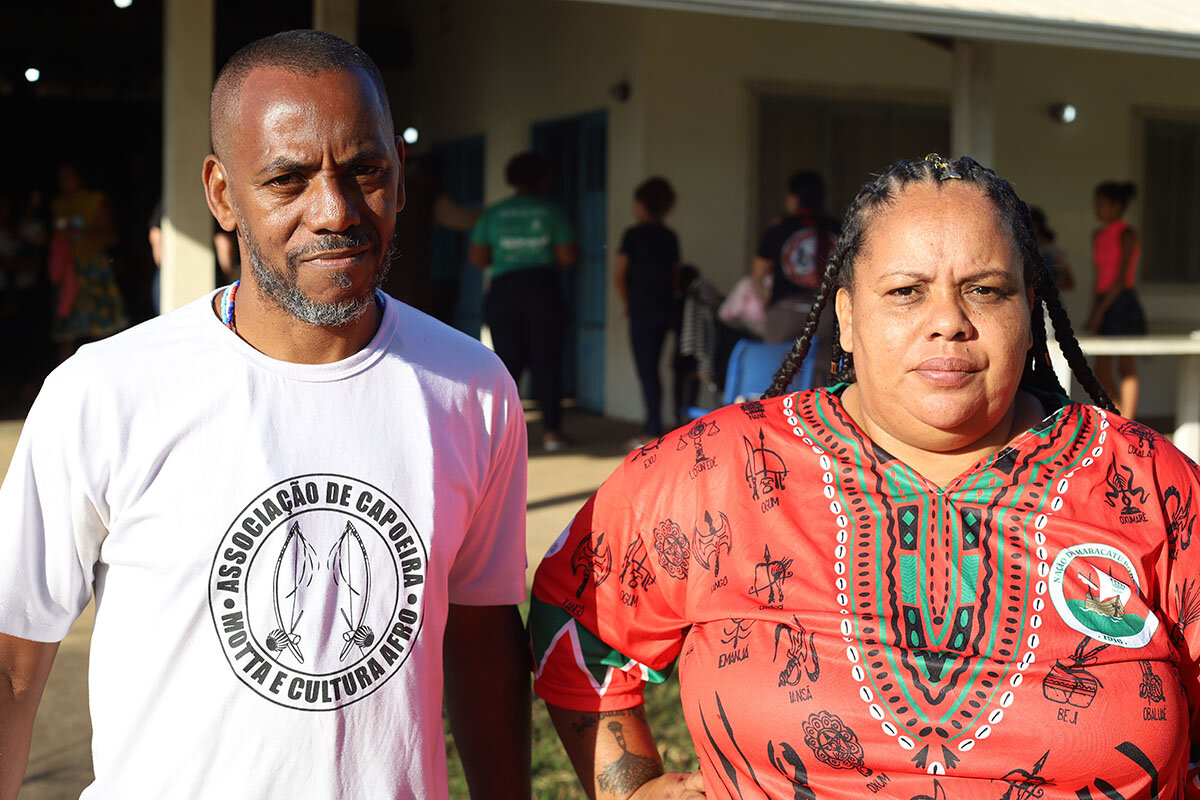
Atanael Motta Jr., a local organizer and capoeira teacher, says the protest was greeted with a mix of ambivalence and hostility.
FDA leaders “received us well,” he says. “But the people that were arriving to the festival waved flags at us to provoke us.”
According to the 2010 census, the most recent, Santa Bárbara is a majority-white city, with just shy of 30% Black and multiracial residents. Ms. Monteiro and others contest the accuracy of those numbers, estimating Black and multiracial residents make up closer to 60% of the population today.
Black community members say the enslavement of their ancestors has long been overshadowed by the story of the enslavers. Mr. Motta, along with his wife, Silvia, opened a cultural center in Americana this year to try and combat that legacy.
“We are resistance,” says Mr. Motta.
“Not against” celebrating ancestors
The Festa Confederada is one of the largest tourist attractions in Santa Bárbara, but it hasn’t always depended on Confederate symbols to draw tourists, says Dr. Brasher. At points over the past 40 years, it’s been a rock festival and a country festival, always leaning into exported stereotypes of U.S. Southern culture.

“We are not against people celebrating their ancestors,” says City Councilwoman Esther Moraes, who wrote and sponsored the law and insists the festival can continue celebrating American heritage. “The issue is the use of Confederate symbols … that represent the oppression that our Black population doesn’t want to carry any longer.”
The FDA is not united in its support for the flag.
“Look to the United States today, and you’ll see how poorly viewed the [Confederate] flag is,” says Jefferson Lafaiette Keese, who advocates for the use of the U.S. flag and plans to be buried with his Confederate ancestors in the Cemitério do Campo.
Mr. Keese calls flying the Confederate flag “an embarrassment.”
Confederate descendant Helena Bittencourt Pfaffenbach remembers a time when the Festa Confederada was more like a family reunion, and wishes the FDA would distance itself from the flag. She’s attended the festival just once over the past 20 years, when her son showed an interest, but says she found it “very commercial.”
“I don’t understand why we have to throw a party to celebrate the Confederate states,” says Ms. Pfaffenbach. “I think we can just celebrate our ancestors, and that’s it.”
Both Mr. Keese and Ms. Pfaffenbach pay the FDA to maintain their families’ gravesites. They still enjoy fond memories of the cemetery: For most of the year, it is a tranquil place. Sunlight pours through the North American pines, while green parrots fly and screech overhead.
“For us, [the law] is an advance,” says Ms. Motta, who opened the nearby Afro-Brazilian cultural center. But “it’s a regression for us to keep talking about American culture instead of Black culture.
“That’s the weight of this flag.”

Difference-maker
Why Nayyab Ali puts her life on the line to protect trans Pakistanis
Progressive laws don’t necessarily translate into safer streets. That’s why Nayyab Ali is dedicated to providing safe harbor for Pakistan’s transgender community.

- Quick Read
- Deep Read ( 6 Min. )
Her friends describe her home like a railway station, with people always coming and going, seeking support or refuge. She also runs a school-slash-shelter, where members of the Khawaja Sira – a centuries-old term that has come to describe transgender communities in Pakistan – can learn the Quran in a safe environment.
And now, as the head of the Transgender Protection Unit of the Islamabad Police, Nayyab Ali acts as a bridge between the trans community and law enforcement, showing up at crime scenes and ensuring cases are dealt with in a serious manner.
Despite progressive laws defending the rights of the trans community, violence and discrimination remain common throughout the country. Many crimes go unreported due to mistrust between trans people and the police, who are often “more interested in treating trans individuals as objects of curiosity” than in processing their complaints, says Ms. Ali. As a victim support officer, she strives to break that cycle.
For Naina, one of the women staying at Ms. Ali’s shelter, knowing she was going to speak to someone in the community gave her the strength to report that she had been threatened with murder.
“Now that there’s someone who fights for us, we feel confident speaking up for ourselves,” she says.
Why Nayyab Ali puts her life on the line to protect trans Pakistanis
In the basement of a residential building in a developing part of Islamabad, a dozen or so transgender women are sitting in a circle on the floor. Not one of them is a stranger to personal tragedy; each has been the victim of violence and exclusion. There is Naina, whose neighbor tried to have her killed over a domestic dispute; Rabia, whose landlord made her beg to earn her keep; and Mehak, who was abused as a child by one of her cousins.
That they are able to tell their stories without reticence or insecurity has much to do with their immediate surroundings. Here, in the Khawaja Sira Quran School, they are under the protection of Nayyab Ali – one of Pakistan’s most prominent and influential trans activists.
Ms. Ali founded the school as a space where members of the Khawaja Sira – a centuries-old term that has come to describe transgender and third-gender communities in Pakistan – could come together and learn the Quran in a safe environment. It also doubles as a shelter where transgender women can stay if they are left with nowhere to go, something Ms. Ali describes as a frequent occurrence.
Despite progressive laws defending the rights of the Khawaja Sira community, violence and discrimination against trans people remain common throughout the country. Five trans women were murdered in March alone this year, and many other violent crimes go unreported due to mistrust between trans people and the police. In her work with the Khawaja Sira Quran School, and as a victim support officer with the Islamabad Police department, Ms. Ali strives to create safe spaces for trans people – something experts agree is desperately needed, even as efforts are made to include trans people in civil society and government.
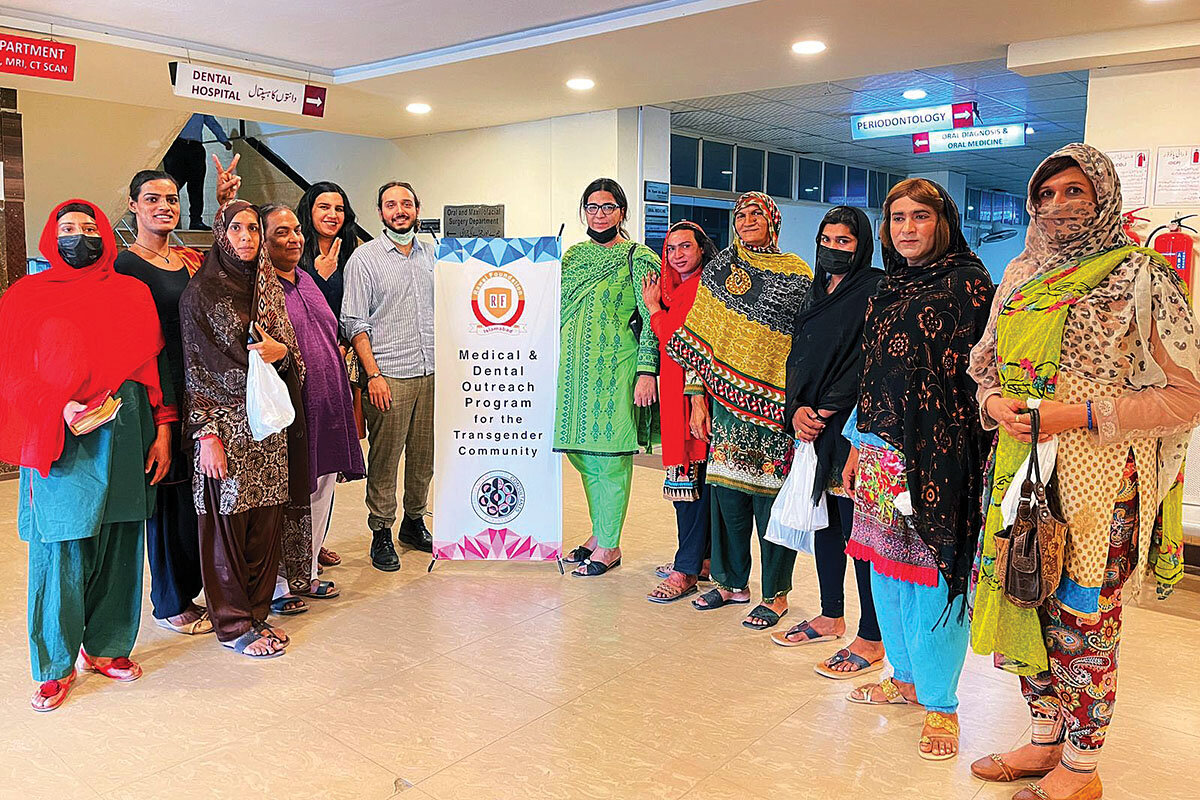
“The trans community in Pakistan is not safe at all,” says feminist academic Farzana Bari, who served as the director of the gender studies department at Quaid-i-Azam University. “If you look at transphobic crime in Pakistan, it seems to be rising. ... At the same time, we also see that the trans community has become collectively organized and developed a collective voice.”
First point of contact
Many of those who come to stay in the shelter first encounter Ms. Ali in her role as the head of the Transgender Protection Unit of the Islamabad Police. The department – the first of its kind in the country – was created to eliminate the gap between the community and law enforcement by placing a trans woman as the first point of contact for victims.
“We never hear of transgender individuals getting robbed or harassed or beaten up in the news,” says Ms. Ali. “When we hear about the community on television, it is typically because a transgender person has been killed, and the reason we only hear about it then is that the pattern of violence that precedes the eventual murder goes unreported.”
This, according to Ms. Ali, is because transgender victims of crime often do not have faith that their cases will be processed by cisgender police officers.
“The problem with law enforcement in our country is that officers are typically less interested in dealing with the incident they have been summoned for and more interested in treating trans individuals as objects of curiosity,” she says. “They are more interested in finding out whether you’re a man or a woman, more interested in your identity and orientation.”
To stop the police from getting sidetracked or exoticizing victims, Ms. Ali makes a point of visiting the crime scene herself, where she acts as a bridge between the police and the complainant.
For Naina – who, like the other trans women at Ms. Ali’s shelter, chose to identify herself only by her first name – the knowledge that she was going to speak to someone in the community gave her the confidence to report that she had been threatened with murder. “Now pretty much every member of the trans community feels reassured that there’s someone who will stand up for them,” she says. “In the past, whenever someone used to harass or threaten us, we used to stay silent, but now that there’s someone who fights for us, we feel confident speaking up for ourselves.”
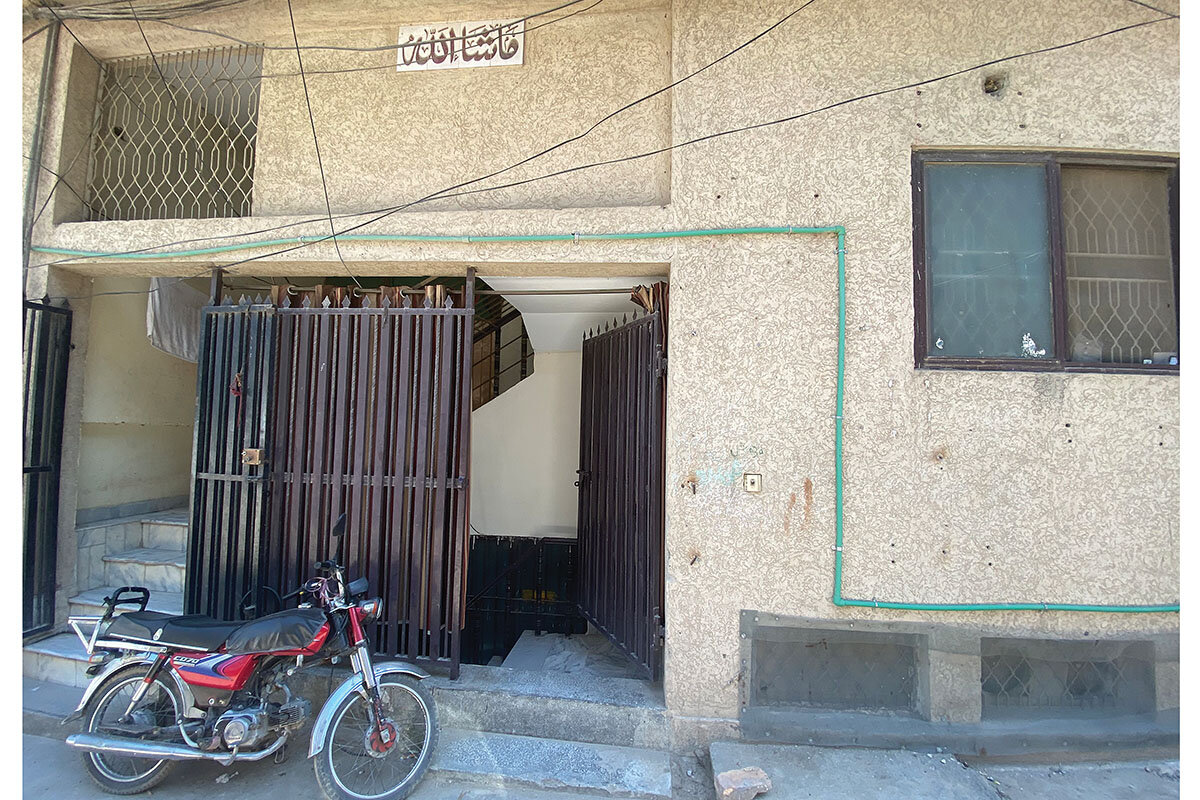
Her words are echoed by Nisha Rao, Pakistan’s first transgender attorney, who describes Ms. Ali as a pillar of strength for the community.
“Even her own home is like a shelter facility. People are always coming and going. It’s like a railway station,” she says, smiling. “Twenty-four hours a day, she is available for the transgender community. She seems to spend every night in the police station advocating for trans victims. ... She doesn’t think about whether she’s going into a slum or a police station or a dangerous part of town. She’s fearless.”
Acceptance and persecution
The transgender community has a long and rich history in the Indian subcontinent. Under Mughal rule, Khawaja Sira individuals held prominent positions as guardians of the imperial harem and many accumulated great wealth and influence in court. When the British took over India in 1858, however, the community was specifically targeted and subjected to a campaign of extermination.
It is this oscillation between acceptance and persecution that has continued to characterize trans people’s status in postcolonial Pakistan.
In May 2018, Pakistan’s Parliament passed a landmark bill allowing transgender people to self-identify their gender and to have this identity recognized on official documents. The Transgender Persons (Protection of Rights) Act also prohibits discrimination against trans individuals in education, employment, access to health care, and property agreements.
In spite of this law, however, members of the Khawaja Sira community are still widely shunned in Pakistani society. Transgender women are often forced to leave home as children and join small communities led by “gurus,” many of whom force them to work in the sex trade or beg on the streets in exchange for shelter.
“We [Pakistanis] are only progressive on paper,” says Ms. Ali. “In the 2018 act, transgender rights are laid down pretty clearly, but the law does not stipulate penalties for those who break it. When you don’t penalize these infractions or set a punishment, in our legal system, it does not qualify as a crime.”
The law is also being challenged in the Federal Shariat Court, the constitutional body tasked with ensuring that legislation remains compatible with the teachings of Islam. According to Dr. Bari, resistance to the act is rooted in the idea of patriarchal supremacy. “The image of masculinity in which the man is strong and controls the subordinate sex is destabilized” by transgender people, she says. “This is a cause of a great deal of patriarchal anxiety.”
Overcoming intimidation
Ms. Ali’s work on the front line of transgender advocacy has made her a target of violent crime.
In 2016, after helping a gang rape victim navigate the legal system, Ms. Ali was doused with acid at a music festival in Muridwala. In the three months that she spent in bed after that attack, a period in which she could barely talk or eat, Ms. Ali says she decided that if she survived, it was because she had been “chosen” to fight for her community.
More recently, she had a gun pointed at her by one of her colleagues in the police department. The officer is now in jail, and Ms. Ali says the incident is still under investigation, but she’s facing pressure to drop the charges.
The experience has left her friends and colleagues fearing for her life. Activist Sherkan Malik, who is cisgender and assists Ms. Ali in her advocacy work, says that he has resigned himself to the fact that “we’re both going to get killed for doing this work.”
But for Ms. Ali, resistance is not a choice so much as a duty. “The truth is we cannot afford to be intimidated,” she says. “If we cow down to these threats and these acts of violence, we will only allow people to oppress us even further.”

Essay
The curse of cursive: Why Dave and I need forensics for our cookware
“Doing what you’re told” came naturally to the so-called Greatest Generation – for their midcentury offspring, not so much. Who knew how that distinction could complicate kitchenware?

- Quick Read
- Deep Read ( 3 Min. )
-
By Murr Brewster Contributor
My husband, Dave, and I argue about whose mom gave us what. Evidently our mothers had the same cookware – the nesting colored Pyrex bowls, the flour sifters with a red knob. We’re never going to agree on the meat grinder.
“See that?” Dave says, pointing to the handwriting in the ancient copy of the “Joy of Cooking.” “That is definitely my mom’s.” I know my mom’s handwriting, too. They are identical.
They were both schooled in the Palmer Method, and adhered to it. Dave and I were, too, but we are midcentury children. As a policy, we didn’t do what we were told.
My fifth grade teacher wrote with little backward threes for the letter “e.” Immediately I began using little backward threes. Lowercase “r’s” became capital “R’s,” only smaller. I believe “g’s” were next. By junior high I was basically printing on a slant. It was a mess.
Cursive is no longer routinely taught. Some educators advocate for it, saying cursive aids in the retention of information. Dave has retained a dead certainty about the meat grinder. He’ll go to the mat for that one. And I’ll let him.
But the krumkake iron was my mom’s. You can’t fake Norwegian.
The curse of cursive: Why Dave and I need forensics for our cookware
My husband, Dave, and I argue about whose mom gave us what. Evidently our mothers had the same cookware. We’ve got the nesting colored Pyrex bowls. We’ve got the flour sifter with the red knob. We’re never going to agree on the meat grinder – the kind you clamp to the counter.
My mom made roast beef hash with hers. Dave’s mom made corned beef hash with hers. We’ll have to bring in the forensics unit to settle it. We each want to claim provenance. We miss our moms, and we don’t want to let go of them.
“See that?” Dave says, pointing to the handwriting in the ancient and grease-stained copy of the “Joy of Cooking” with the sprung spine and loose pages. “That is definitely my mom’s. I know her handwriting.” I know my mom’s handwriting, too. They are identical.
They were both schooled in the Palmer Method of cursive writing, and not only were they drilled in it – as were we – but they also adhered to it. Dave and I are midcentury children. As a matter of policy, we didn’t do what our elders told us to do.
I didn’t, anyway. Dave, though, still has what used to be called “an elegant hand.” His cursive is regular and graceful. It impressed me when I met him. Somehow, it seemed that if a man had an elegant hand, it said something about his character.
As it turned out, it did. Dave learned the Palmer Method as we all did, and no doubt fell away, but then picked it up again in middle school. Specifically, he wanted to write exactly the way his mom did. That way, he could write his own excuse notes. To this day, although he is not otherwise an exceptional speller, he can correctly spell “diarrhea.”
The Palmer Method was designed to be easy and efficient. I also recall that one was supposed to move the pencil with one’s whole arm, rotating comfortably from the padded portion of your resting forearm. One was not supposed to move the pencil with just the fingers.
When the teacher wasn’t looking, we moved the pencil with just our fingers. As a result, our hands got crampy and tired, and our handwriting deteriorated.
Where a lot of us went really wrong was deciding we should be more artistic about our handwriting. Ah, wayward youth! No, we should not. My fifth grade teacher wrote with little backward threes for the letter “e.” It looked cool. Immediately I began trying to jam in little backward threes, and that took some jamming. They don’t really fit that well. Not only that, but they don’t hook up to any of the other letters. So every time an “e” came up in a word, which is often, I had to lift the pencil to get it started, and before long I was lifting it for other letters too. The Palmer Method “r” didn’t look like an “r” until I’d written it as a capital letter, only smaller. I believe “g’s” were the next to get complicated. By the time I was in junior high I was basically printing, only on a slant, with many of the letters miniaturized uppercase versions.
It was a mess. The Palmer Method sends graceful cursive gazelles loping across the page. My script looks like I opened up the monkey cage. I can’t read my own writing. I’ve kept scraps of paper on which I have scribbled something important, probably. We’ll never know.
These days, kids have mad keyboard skills but cursive writing is no longer routinely taught, although many educators are advocating for it again. Among other things, they say you should learn cursive to be able to write and sign checks.
That may not be the selling point they think it is.
Also, you should learn cursive so you can read other people’s cursive. This won’t come up often. Many children are cursive-illiterate in their own language. When Grandma’s handwritten birthday letter shows up with an antique check floating out of it, they are completely stupefied, but bless their modern hearts, they do know which recycling bin it all goes into.
The more compelling arguments include that cursive improves people’s fine motor skills and aids in the retention of information.
Dave – with his elegant hand – has retained a dead certainty about the meat grinder. He’ll go to the mat for that one. And I’ll let him do it.
But the krumkake iron was my mom’s. You can’t fake Norwegian.
Other headline stories we’re watching
(Get live updates throughout the day.)The Monitor's View
Blissful are Kenya’s peacemakers
- Quick Read
- Deep Read ( 2 Min. )
-
By the Monitor's Editorial Board
Journalists often focus on the conflict of elections, yet in a welcome change, a big story in Kenya before last week’s presidential election was a grassroots effort to keep the peace, both before and after the Aug. 9 vote.
One reason peacemaking in Kenya was news is that memories remain fresh about the hundreds of people killed after elections in 2007 and 2017 amid ethnic-driven violence over allegations of vote-rigging. It has taken a range of activists, from artists to religious leaders, to remind Kenyans where peace comes from. “Let us remember that peace starts with me and we have no other country to run to other than Kenya,” Jennifer Riria, chairperson of the Women Mediators Network, told the Daily Nation.
Kenya’s expanding network of peace activists may be a model for other democracies – including the United States. For now at least, it is simply as newsworthy as the Kenyan election itself.
Blissful are Kenya’s peacemakers

Journalists often focus on the conflict of elections, yet in a welcome change, a big story in Kenya before last week’s presidential election was a grassroots effort to keep the peace, both before and after the Aug. 9 vote.
One reason peacemaking in Kenya was news is that memories remain fresh about the hundreds of people killed after elections in 2007 and 2017 amid ethnic-driven violence over allegations of vote-rigging. “The first thing that matters the most to Kenyans,” said Amriya Issa, a member of Sisters Without Borders, “is maintaining peace during the electioneering period.”
It has taken a range of activists, from artists to religious leaders, to remind Kenyans where peace comes from. “Let us remember that peace starts with me and we have no other country to run to other than Kenya,” Jennifer Riria, chairperson of the Women Mediators Network, told the Daily Nation.
Political violence is still possible after last week’s election. On Monday, a few hundred people stormed the streets of Kisumu, Kenya’s third largest city, after the head of the election commission announced that candidate Raila Odinga had lost to rival William Ruto by a slim margin. Yet the next day, Mr. Odinga urged supporters to keep calm and not “take the law into their own hands” even as he made a legal challenge to the official count. The tightness of the final tally may lead to disruptions, the Eurasia Group consultancy said in a note, but “widespread unrest remains unlikely.”
To the credit of Kenya’s peacemakers, the European Union praised the “peaceful atmosphere” during the campaign. Efforts to prevent violence began in earnest last April during the Easter season. Clergy united to give sermons about peace as part of daily life.
“Let’s not use words to insult people, words that are going to discourage someone, but uplifting words. And let us be truthful and moderate in all we do,” said Anglican Church of Kenya Archbishop Jackson Ole Sapit in one sermon.
Other actions included a campaign by artists in Kibera, Kenya’s largest slum area, to display works that celebrate the country’s ethnic diversity. One group of activists organized a “peace caravan” across the country carrying messages about remaining calm during the heated election.
The Inter-Religious Council of Kenya trained young people on how not to be exploited by politicians and how to react wisely to falsehoods on social media. The National Youth Council held a prayer day to encourage peace promotion. The EU paid for a “hackathon” to develop ways on mobile phones to build peace.
Kenya’s expanding network of peace activists may be a model for other democracies – including the United States. For now at least, it is simply as newsworthy as the Kenyan election itself.

A Christian Science Perspective
Each weekday, the Monitor includes one clearly labeled religious article offering spiritual insight on contemporary issues, including the news. The publication – in its various forms – is produced for anyone who cares about the progress of the human endeavor around the world and seeks news reported with compassion, intelligence, and an essentially constructive lens. For many, that caring has religious roots. For many, it does not. The Monitor has always embraced both audiences. The Monitor is owned by a church – The First Church of Christ, Scientist, in Boston – whose founder was concerned with both the state of the world and the quality of available news.
A lesson from the tala
- Quick Read
- Read or Listen ( 4 Min. )
-
By Mari G. de Milone
Like the South American tala tree breaks through rocky conditions to reach the sunlight, so we can seek the light of God in difficult times – which opens the way to healing, as a woman experienced when she was healed of asthma she’d struggled with since childhood.
A lesson from the tala
The tala is a deciduous tree that is part of the native flora of my country, Uruguay. We find it in all types of soils, but mostly in rocky terrain. There it sprouts and grows in conditions that would be almost impossible for other types of trees. The tala is able to adapt to the most unforgiving environments; although it takes some time, the tala’s small shoots break through even the hardest rocks in their eagerness to reach the sunlight.
The tala’s resistance to being overcome by the aridity and harshness of its surroundings, and its ability to thrive in spite of such surroundings, give me something to think about. Like the tala, we can sometimes find ourselves in difficult environments – oppressed by inhumane conditions, beaten down by fear, sickness, resentment, or the past. We may even find ourselves walking through life burdened by such limiting conditions, none of which come from God.
In the Bible, Genesis 1 records that God created His children – all of us – in His image and likeness and that we have dominion over the earth. And in his letter to the Romans, the Apostle Paul speaks of “the glorious liberty of the children of God” (Romans 8:21).
The knowledge of our spiritual identity – in other words, of what we are as children of God – allows us to start discerning all the wonders of infinite Love, God, such as health and peace, to which we are fully entitled. Aspects of this limitless understanding may come in a moment of spiritual insight as well as gradually through persistent prayer and spiritual growth. Whichever is the case, it comes as we dedicate ourselves to the study and practice of Christian Science.
I know this to be true. When I was very young, I was diagnosed with asthma. Whenever I had an asthma attack, I had to stay in bed for several days, which meant of course I couldn’t attend school. I was treated with everything that medicine considered appropriate to temporarily mitigate the disease. It was not at all easy, not for my family and not for me.
The prognosis was that when I reached adolescence, the asthma might ease or even disappear. But none of that happened. On some occasions it even got worse, and I had to sleep outdoors when I could no longer bear the humidity of indoor spaces. It was the only way I could breathe normally.
Becoming acquainted with Christian Science was like discovering a new world – a world full of light and freedom that allowed me to learn more about the God I’d loved from a very young age, and simultaneously about myself as His image and loved child. I began to study this Science with lots of enthusiasm, which increased when I saw that it was possible to overcome problems through prayer.
However, not for a moment did it occur to me that asthma could also be overcome by this spiritual method of healing, because I had accepted it as always having been a part of me. Yet, I continued to study Christian Science, even as there were increasing demands on my time over the years to care for my family.
The sudden realization several years later that I could breathe freely, no matter what environment I was in, was a most wonderful discovery. The healing had happened so imperceptibly, but was at the same time unstoppable. I compared it to the seasons that arrive almost without our taking notice, and yet nothing and no one can stop their course.
It was then that I understood that the perfection of God’s work (in other words, the whole universe, which includes me) is constantly manifesting itself whether we know it or not, and whether we claim it or see it or not. The study and practice of Christian Science allows us to perceive divine Mind’s grand, spiritual creation more clearly, which opens the way to healing.
My complete freedom from asthma continues to this day. The affliction that seemed to mark me since childhood disappeared as the truth of being dawned in my consciousness.
Just as the rocky ground cannot stop the growth of the tala, no earthly condition can stop the healing impetus of divine Truth and prevent us from finding our God-given freedom from the restrictions of mortal and material assumptions and conditions. As described in the words of the discoverer of Christian Science, Mary Baker Eddy, “Truth crushed to earth springs spontaneously upward, and whispers to the breeze man’s inalienable birthright – Liberty” (“The First Church of Christ, Scientist, and Miscellany,” p. 128).
Para leer este artículo en español, haga clic aquí.
Adapted from an article published on the website of The Herald of Christian Science, Spanish Edition, April 11, 2022.

A message of love
Puddle perspectives

A look ahead
Thanks for joining us today. Come back tomorrow for a story about how families in Gaza prepare for potential emergencies, such as rocket attacks, when there are few safe places left to go.


